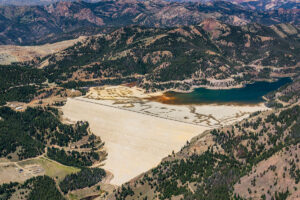An Update on the Thompson Creek Mine in Central Idaho
In March 2020, a magnitude 6.5 earthquake jolted residents of central Idaho - the second largest seismic event in the state’s recorded history. In the immediate aftermath of the quake, the first thought of many ICL’s staffers was, “Is the Thompson Creek tailings dam still standing?” Looming just a few miles from the Salmon River, the 600-foot-tall sand dam holding back mine tailings at the Thompson Creek molybdenum mine near Challis can seem like an environmental catastrophe waiting to happen. Luckily, that earthquake did not result in any damage to the dam or the release of hazardous materials (see our April 2, 2020 blog post for a full recap of that event). However, that event did serve as a potent reminder that this area of central Idaho is quite seismically active and that the engineering specifications of the original tailings dam may not be sufficient given our current understanding of the area’s seismic hazard. In the aftermath of the M6.5 quake, ICL sent a series of letters to the mining company (Centerra Gold) and the task force of state and federal agencies that oversee the site. In our communications, we requested that Centerra establish an independent tailings review board to provide additional oversight. We also requested that they reassess the seismic hazard on site and increase the stability of the tailings dam depending on their findings. To follow up on those requests, several ICL staff and board members had the opportunity to tour the mine site last month with representatives from Centerra and the Bureau of Land Management. Our primary objective for this tour was to get up to speed on the latest happenings on-site and continue to advocate for heightened oversight and engineered stability at the tailings dam. On the tour, we learned that:
In the aftermath of the M6.5 quake, ICL sent a series of letters to the mining company (Centerra Gold) and the task force of state and federal agencies that oversee the site. In our communications, we requested that Centerra establish an independent tailings review board to provide additional oversight. We also requested that they reassess the seismic hazard on site and increase the stability of the tailings dam depending on their findings. To follow up on those requests, several ICL staff and board members had the opportunity to tour the mine site last month with representatives from Centerra and the Bureau of Land Management. Our primary objective for this tour was to get up to speed on the latest happenings on-site and continue to advocate for heightened oversight and engineered stability at the tailings dam. On the tour, we learned that:
- The mine is currently under “care and maintenance” - meaning that no actual mining is presently occurring, just the processing of a moderate amount of ore mined elsewhere.
- The previously permitted ‘Phase 8’ of the open-pit mine may get underway as early as next year if Thompson Creek’s parent company approves the expansion and molybdenum prices stay high. If it goes forward, Phase 8 will be the final phase of the mine (at least in its current configuration).
- Centerra has reassessed the seismic hazard at the site and found that the maximum credible earthquake at the site is a M7.1 (expected to happen roughly once every 5000 years). If the mine goes through its Phase 8 expansion, the closure criteria to maintain the long-term stability of the dam into perpetuity will necessitate the re-engineering of the tailings dam to withstand up to that potential M7.1 earthquake. If these engineering changes are made, the dam would theoretically be able to withstand an earthquake eight times stronger than under its current design configuration.
- Centerra has established an Independent Tailings Review Board made up of professionals with expertise in geotechnical engineering, civil engineering, and hydrogeology from multiple companies not involved with the Thompson Creek Mine’s operations. The role of the Tailings Review Board is to implement an international standard of care for the operations, maintenance, and surveillance of the tailings dam, as well as provide an independent source of input/review for design criteria and/or modifications for any expansions.
While we are encouraged by the changes made in response to the increased seismic hazard at the site, ICL will nonetheless continue to serve our long-standing ‘watchdog’ role concerning the Thompson Creek Mine and hold the company to the highest safety standards possible for their tailings dam.

